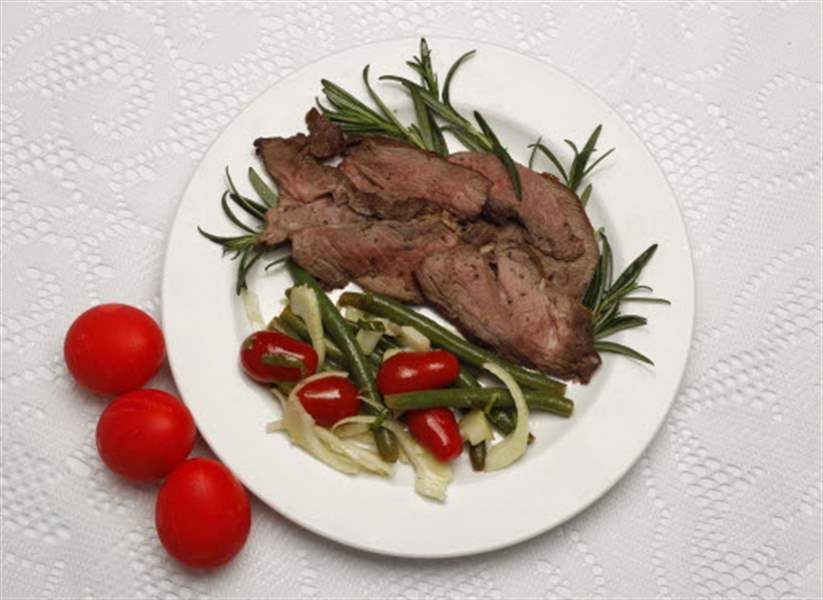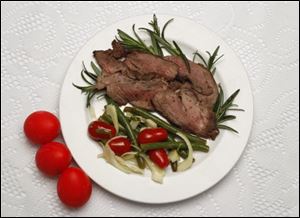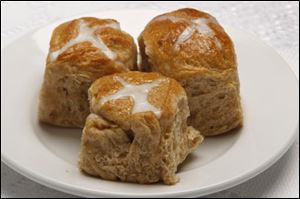
RECIPES
Easter traditions: Hop on over and try something different this holiday
4/19/2011
Traditional Easter food includes grilled lamb, hot cross buns, and hard boiled eggs.
THE BLADE/DAVE ZAPOTOSKY
Buy This Image

Traditional Easter food includes grilled lamb, hot cross buns, and hard boiled eggs.
Easter is a time of tradition: Easter eggs, chocolates, hot cross buns, Easter pizza.
Easter pizza?
Yes, throughout Italy Easter just isn’t Easter without a pie made with meat, eggs, and cheese. Known colloquially as Easter pizza, the dish varies from region to region — in Sicily, it has macaroni and pork in the middle, in Calabria it’s sausage, ham, and hard-boiled eggs.
It’s not just pizza; the holiday is celebrated in many different ways around the globe. In Russia, they make pashka, a molded cheese-curd dessert in the form of a pyramid. In Finland, it’s mämmi, a thick, pudding-like dessert often served in milk. Some Hungarians serve smoked ham with hard-boiled eggs and pickled horseradish. In South America, they eat clipfish, cod that has been dried and salted.
But no matter how it is celebrated, the idea is the same. Easter is a spring holiday, a time of rebirth and renewal. Although it now specifically honors the resurrection of Jesus, similar celebrations date far back into Pagan antiquity.
Because the Last Supper was a Passover Seder, according to tradition, it is probable that Jesus ate lamb at the meal. At the time, while the Second Temple still stood in Jerusalem, lamb was an integral part of the Seder meal among Jews.
In America today, Easter lamb typically is served oven-roasted. Our recipe is just as simple to make, or nearly, despite its daunting (but descriptive) name — Grilled Butterflied Leg of Lamb with Garlic and Rosemary. The intriguing difference in flavor comes from the grill, that woodsy earthiness that you only get from meat roasting above flames or hot coals. This particular recipe comes from the Provence region of France, though similar methods are used all around the Mediterranean Sea.
Julia Child has a similar recipe with Dijon mustard (Gigot a la Moutarde) that she roasts in the oven. I have used her marinade and then grilled the lamb, which also is excellent. The Provencal version has a simpler, more forthright flavor that doesn’t seem like it is trying too hard, but you certainly wouldn’t go wrong to add a half-cup of Dijon mustard, a couple of tablespoons of soy sauce, and a little bit of fresh or powdered ginger to the marinade.
And keeping the idea of Dijon mustard in mind, this grilled lamb makes an exceptionally good sandwich the next day. Just spread a little Dijon on good bread, add lettuce, tomato, and a bit of cheese and you’re in leftover heaven.
For a bit of green to go with the lamb, we created a salad that draws its flavors from the same region. Green beans are always an excellent choice with lamb, especially French green beans, haricot verts. To these we have added cherry tomatoes — always a classic combination — and the fragrant, anise taste of fennel. A simple dressing of lemon juice and olive oil adds a bright freshness.

Hot cross buns are a Good Friday tradition.
Our recipe comes from The Original King Arthur Flour Cookbook, which might be why it includes whole wheat flour as well as all-purpose flour. Most recipes typically only use the all-purpose flour, but use the whole wheat if you have it as well. It provides a nutty flavor that is otherwise missing, a great backboard to bounce off the cinnamon, nutmeg, and allspice. And this recipe also calls for a sponge, in the baking sense as opposed to the soaking-up-water sense. It’s a little extra work, but it creates a yeasty undertone that enhances the rolls’ sweet airiness.
One endearing tradition among the Orthodox churches is the making of red Easter eggs. In an unusual conjunction of calendars, the Orthodox and Western Easters fall on the same day this year, Sunday. So no matter what your background, you might want to put out a bowl of bright red Easter eggs, which will certainly add color to your table. Some families like to crack the eggs against each other, and the person who has the last uncracked egg is said to receive a year of good luck.
It couldn’t hurt to try.
Contact Daniel Neman at dneman@theblade.com or 419-724-6155.
RECIPES
Grilled Butterflied Leg of Lamb with Garlic and Rosemary
8 garlic cloves
1 teaspoon kosher salt
1 tablespoon chopped fresh rosemary
1 boneless, butterflied leg of lamb, 4-5 pounds (see cook’s note)
1 tablespoon olive oil, extra virgin
2 teaspoons coarsely ground black pepper
Cook’s note: Once the bone has been removed the lamb is nearly butterflied. Slice most of the way through any particularly thick parts so the entire piece of meat is more or less the same thickness.
Chop the garlic. Sprinkle the salt over it, and mince it with a chef’s knife, occasionally smearing it with the flat side of the knife, until it becomes like a paste. Add the rosemary and continue to mince.
Lay the lamb out flat and moisten it with some olive oil. Spread the garlic-and-rosemary paste on both sides. Let sit for at least 1 hour at room temperature or up to 24 hours, covered in plastic wrap and refrigerated. Prepare the grill to medium high. Sprinkle the lamb on both sides with the pepper.
Grill the lamb on one side for about 10 minutes, watching for flare-ups. Turn the meat over and cook until a thermometer inserted in the thickest part of the meat registers 125-130° for medium rare, another 15 minutes or so. Transfer the meat the a cutting board and let it rest, loosely covered in aluminum foil, for 10 minutes. Carve the meat across the grain in thin slices.
Yield: 8 servings
Source: Bistro Cooking at Home, by Gordon Hamersley with Joanne McAllister Smart
Green Beans and Fennel Salad
1 pound green beans or haricots verts
1/2 fennel bulb, sliced thin
1 1/2-2 cups cherry tomatoes
Salt and pepper to taste
2 tablespoons olive oil
4 tablespoons lemon juice
1/2 teaspoon fennel seeds
4-6 leaves basil OR mint, sliced thin
Steam green beans or haricots verts over boiling water until done, 3-5 minutes. Strain under cold water to stop the cooking.
In a large bowl, add the beans, fennel slices and cherry tomatoes. Season with salt and pepper. In a small bowl, whisk together olive oil and lemon juice, and pour over the top. Sprinkle with fennel seeds and basil or mint. Serve at room temperature or chilled.
Yield: 8 servings
Hot Cross Buns
The Proofing Sponge:
1/2 cup warm milk (110-115°)
1 teaspoon sugar
2 tablespoons or packets active dry yeast
1/2 cup whole wheat flour
The Rest:
1 cup milk
1/3 cup brown sugar
2 eggs
1 Cup whole wheat flour
1/2 cup (1 stick) butter, at room temperature
1 1/2 teaspooons salt
1 teaspoon cinnamon
1/2 teaspoon nutmeg
1/2 teaspoon allspice
1/2-1 cup raisins, optional
3 1/2 cups all-purpose flour
1 egg (for wash)
2 teaspoons milk (for wash)
The Glaze:
1 1/2 cups powdered sugar
1/2 teaspoon vanilla OR 1 teaspoon lemon juice
1-2 tablespoons milk, as needed
Starting the sponge: Put the warm milk in a large mixing bowl and mix in the sugar, yeast, and flour. Let this small sponge sit 10-15 minutes. It may become bubbly.
Making the dough: Add the milk and brown sugar to the sponge. Beat in the eggs and add the whole wheat flour. Stir in the butter, salt, spices, and optional raisins. Mix in the all-purpose flour until the dough holds together and pulls away from the sides of the bowl. This will make a soft but kneadable dough.
Turn the dough out onto a lightly floured surface and knead 3-4 minutes. Give it a rest while you clean and grease the mixing bowl. Knead the dough another 3-4 minutes or until it’s smooth and satiny. Add only enough flour to keep it from sticking to you or the board.
Place the dough in the mixing bowl, turning it so the top is greased. Cover with a cloth and place it somewhere cozy (inside the oven with the light on works well) and let it rise until it has doubled or until you can leave a deep fingerprint in it, 1½-2 hours.
Punch it down, return it to the floured board and divide it in half. Roll each piece into a 16-inch-long “snake,” cut each one into 16 pieces, and roll each piece into a ball. Grease two 9-inch-square cake pans and place 16 balls in each. Cover and let rise 45 minutes to an hour.
About 15 minutes before you want to bake, preheat the oven to 350° (make sure the rising rolls are not in the oven). Just before they go in, cut a cross in each using a serrated knife or a razor blade. Saw gently back and forth without exerting much downward pressure so you don’t deflate them.
Mix the milk and egg to make an egg wash. Brush the surface of the buns with the egg wash. Bake for 20-25 minutes or until they are golden brown.
Making the glaze: While the buns bake, make the glaze by mixing the powdered sugar and vanilla or lemon juice. Gradually add the milk until you can drizzle the mixture in a fine line. For a shiny, sweet surface, drizzle the glaze over the entire bun right after it comes out of the oven. Or, to make the cross more apparent, let the buns cool and drizzle the glaze just through the cross to leave a distinct white trail.
Yield: 32 buns
Source: The Original King Arthur Flour Cookbook
Greek Easter Eggs
Uncooked eggs
Water
3/4 cup vinegar
Red food dye or coloring
Vegetable oil
A few cotton balls
Wash and dry each egg. Put enough water in a pot to cover the eggs, add the vinegar, and stir in food dye or coloring. Add the eggs and bring the water to a boil. Remove the pot from the heat, cover, and let sit 15 minutes if the eggs were room temperature, 17 minutes if they came out of the refrigerator. Remove from the pot with a slotted spoon. Wipe the eggs with an oil-soaked cotton ball, then dry them with a paper towel. Be careful, the dye can still transfer to clothing at this point. Serve cold.
Pizza China/Pizza Rustica (Italian Easter Pie)
Filling:
2 cups cooked, smoked ham, cubed
2 cups cooked Italian sausage, sliced
1 cup mozzarella cheese, cubed or shredded
1/2 cup chopped parsley
4 hard boiled eggs, chopped
1 cup Italian basket cheese, cubed (optional)
1 cup ricotta cheese
3 eggs, uncooked
Black pepper to taste
Mix all chopped ingredients in large bowl.
Place uncooked eggs and Ricotta cheese in blender container and mix on medium speed for about 1 minute.
Pour into large bowl and combine everything well.
Divide dough in half and roll (and beat/stretch if necessary) to fit large pie pan or 15-inch pizza pan.
Place one circle on bottom of pan. Top with the filling, pressing out all air pockets. (Pie will look too full.)
Top with remaining dough. Trim around pan with knife leaving about 1 inch extra all around. Press edges to seal and tuck sealed edge in all around pan. (Don’t be afraid to use fingers.) Pat back into pan, if misshapen.
Stick top with fork several times to make air holes. Bake at 400° for 20 minutes, then reduce oven temperature to 350° and bake an additional 30 minutes. If you like the top shiny, brush with beaten egg yolk.
Place foil or pan on rack underneath to save oven from drips as they usually do leak.
Crust:
4 cups flour
1 teaspoon salt
1 package granulated yeast
1/4 cup olive oil
1 1/2 cup hot water
Place flour and salt in large bowl.
Combine hot (from tap) water, oil, and yeast in measuring cup with fork or whisk.
Add to flour and mix well. If dough is dry, add water as necessary. If dough is too sticky, add flour, one tablespoon at a time. Knead until dough forms ball.
If using the same day, leave in bowl in warm place to rise. Punch down before rolling. Dough may be frozen for 3 months.
Any Italian bread or pizza dough may be purchased for this. White bread dough will not get as crusty and may become wet underneath filling.
Yield: 1 pizza
Source: cooks.com